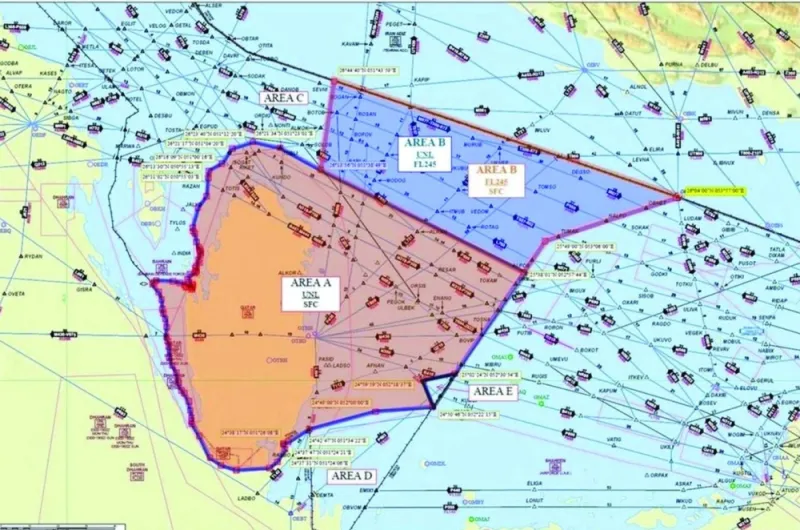Today, Qatar’s airspace is established in full after the success of the completion of the second phase of ICAO’s plan for a full, first-ever establishment of airspace for Qatar.
Last year, when ICAO and its member states on the council reached a decision that Doha FIR (flight information region – an airspace area) shall be established in two phases, the organisation finalised a plan that will see the airspace established in two phases. In the diagram, “Area A” of the Doha FIR would be an ‘unlimited altitude’ area controlled by Qatar, effective in 2022. “Area B” would be controlled by Qatar to an altitude of 24,500ft, but within 2 years, Area B would join Area A in becoming an unlimited altitude area to form the final shape of Qatar’s airspace.
Following a smooth implementation of the airspace, today Qatar becomes the ‘responsible authority’ for the entire airspace area (FIR), combining Area A and Area B to form one large airspace area, controlled by Doha from surface level to an unlimited altitude, including over the international waters.
ICAO’s decision last year was a historic verdict for aviation in the Middle East. The UN special agency for aviation “ICAO — the International Civil Aviation Organisation” agreed to establish a brand new, first-ever airspace for the State of Qatar known as the “Doha FIR” — redrawing the skies of the world’s airspace map for the first time in decades.
ICAO is the UN agency with the authority to delegate which country is responsible for the operational control of a given ‘flight information region’, which is known in the industry as an ‘FIR’ – essentially, an airspace area on the map of the skies.
The establishment of a Doha FIR has shrunk Bahrain’s existing airspace and stretches out east towards the UAE, and north towards Iran. The Doha FIR was approved by ICAO council member countries, which include the United States, South Africa, Singapore, Greece, and Gulf neighbours Saudi Arabia and the United Arab Emirates.
It’s a milestone for Qatar, as there are no examples in the modern history of the airspace map of the world changing to include a country that had no airspace (FIR) of its own.
With a new FIR of its own, Qatar has gained much-needed airspace independence, and the country will have the ability to maximise the efficiency of air travel around Qatar to better meet the country’s air travel sustainability goals. Qatar will further benefit from overflight fees paid by other airlines for using its airspace – which is common practice in aviation.
The development concludes a long process which follows ICAO’s initial conclusion in June 2021 when it “agreed on a Doha FIR in principle.” The organisation then went on to spend time working with Qatar, Bahrain, UAE, Iran, and other aviation industry stakeholders to determine a final drawing of the “Doha FIR” – which was successfully established in its first phase as a working, active airspace area in early September 2022.
For decades, the skies above the Middle East were disproportionally divided. Whilst most regions on earth have airspace split up equally among countries, airspace in the Gulf is unusually shaped. Bahrain has held control of most of the airspace above the Gulf with its ‘Bahrain FIR’ that stretches from Kuwait, across the Gulf, to the bordering FIR of the United Arab Emirates.
Airspace in the region had previously been determined based on where military radars had been installed, and with a history of good, ‘brotherly’ relations between Qatar and Bahrain, (both being Gulf Co-operation Council countries and being members of ICAO’s Transit Agreement, which permits freedom of the skies), Qatar had agreed for Bahrain to continue to control and manage its disproportionally large area of airspace.
Back then, it was also acknowledged that Bahrain would continue to profit from overflight fees (the fees airlines must pay for passing through a country’s airspace) of one of the busiest transit areas in the world.
In 2017, the sudden blockade on Qatar pushed the unusual distribution of airspace in the Gulf into the spotlight for the very first time. Whilst the UAE, Saudi Arabia and Egypt joined Bahrain in announcing the immediate closure of their airspaces to all Qatari registered aircraft (found later to be a breach of ICAO’s Chicago Convention), the announcement of the closure of Bahrain’s airspace had been the most critical for Qatar.
Recognising the risk of having skies controlled by another country, in 2018 Qatar accelerated its formal proposal to the ICAO for the establishment of its airspace in what would become known as the Doha FIR.
Following years of technical assessments, hearings and council sessions, the organisation’s council has worked with technical teams to outline, facilitate, draw the coordinates of a Doha FIR and finally: implement the airspace in two separate phases.
Reflecting on the completion of the final phase of the implementation of the Doha FIR, Qatar’s Minister of Transport HE Jassim bin Saif al-Sulaiti said he appreciated the efforts of the ICAO Council and thanked member states along with the civil aviation authority, technical teams, and Qatari aviation sector stakeholders who contributed to the successful implementation of Qatar’s first ever airspace.
The author is an aviation analyst. Twitter handle: @AlexInAir


Alex Macheras
